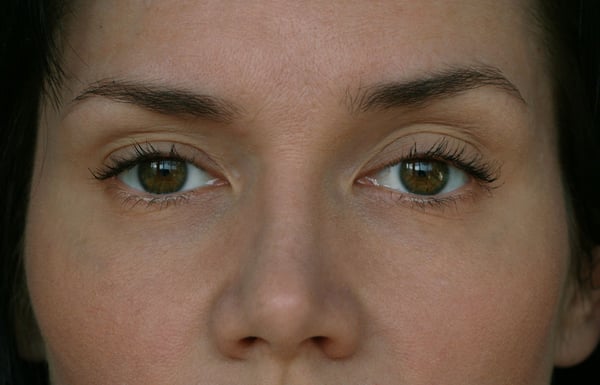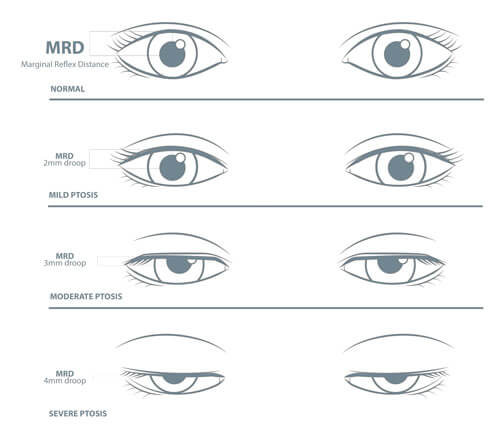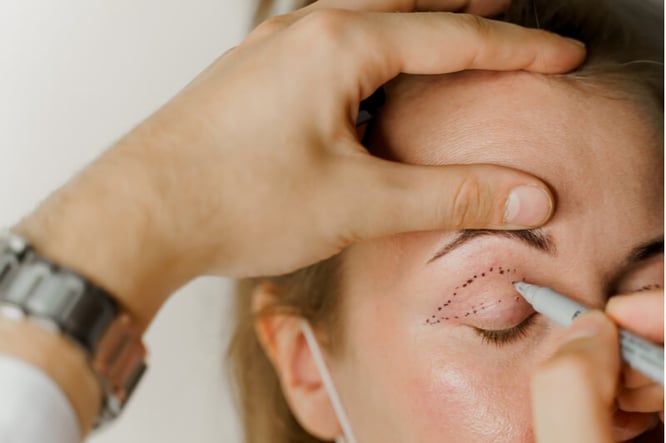Ptosis Surgery Singapore - Droopy Eyelids Correction
.png)
Table of Contents
- What is Ptosis?
- Causes of Ptosis
- How is Ptosis diagnosed?
- How can Ptosis be corrected?
- Who performs Ptosis surgery?
- What happens during ptosis surgery?
- How much does ptosis surgery cost in singapore?
- Can i use medisave/insurance for ptosis surgery?
- What are the risks of ptosis surgery?
- What to expect after ptosis surgery?
- Are the results permanent?

What is Ptosis?
Ptosis, also commonly known as drooping eyelids, is a condition where the upper eyelid droops over the eye to an abnormal or bothersome degree. The reasons for getting ptosis treated can be out of aesthetic and/or medical consideration. From the aesthetic viewpoint, having ptosis may make one look perpetually tired, or appear older than their actual age. In more serious cases, ptosis can affect one’s vision and become a hindrance to their daily activities. People with ptosis may also experience headaches as a result of straining their forehead muscles, or even encounter accidents, as functional obstruction of the visual field, may be potentially dangerous in situations such as driving.
Causes of Ptosis
Ptosis is directly related to the functioning (or malfunctioning) of the levator muscle, as which is the main muscle known as the muscle that lifts the upper eyelid. The cause of ptosis can be congenital (i.e., genetic) or acquired later on in one’s life.
Congenital Ptosis
Congenital ptosis usually presents as a birth defect. It is most commonly due to the maldevelopment of the levator palpebrae superioris muscle, and usually affects only one eye.
Ageing
A more common cause of ptosis is ageing, as skin becomes lax and the levator muscles elevating the upper eyelid become attenuated when one grows older. Most people notice the beginnings of ptosis in their late 30s or early 40s. We also see many elderly people affected by this condition.
Injuries & Trauma
In some cases, ptosis can also be caused by injuries to the levator muscle or nerves controlling the muscle, as a result of physical trauma.
Other Medical Conditions
Droopy eyelids may also be related to other medical conditions, such as tumours, neurological disorders, infections, and stroke.
How is Ptosis Diagnosed?
While the symptoms of ptosis are usually apparent, a proper medical examination is still required to understand the causes and extent of the condition, so that a suitable treatment can be prescribed. The following are the types of examinations that may take place:
Marginal Reflex Distance (MRD) Measurement
The diagnosis for ptosis can take place when your overall eye health is assessed by the ophthalmologist during a comprehensive eye exam. To determine the quality of your vision and to see if it is being affected by ptosis, a visual field test or a test measuring the Marginal Reflex Distance (MRD 1) may be performed. The Marginal Reflex Distance refers to the distance measured from the pupil’s centre to the upper lid. In order for one’s condition to be diagnosed as ptosis that poses a functional problem coverable by insurance or Medisave claim, the MRD measurement needs to be 2 millimetres or less.
Levator Function
To determine the degree of severity of the patient’s ptosis, we also perform a test which looks at the levator function. During the test, the doctor holds a thumb against the patient’s eyebrow while they look downwards, so as to ensure that only the levator muscle in the eyelid is used. The patient is then to look upwards and the how much the eyelid moved is measured.
The following measurements of eyelid movement indicate varying levels of ptosis severity:
- Good (>10 mm)
- Moderate (5-10mm)
- Poor (0-4 mm)
Severity of Drooping
Another important factor to determine the severity of ptosis is the measurement of droop.
- Minimal or mild ptosis (1-2 mm)
- Moderate ptosis (3-4 mm)
- Severe ptosis (>4 mm)

The above are some standard tests to be taken during ptosis diagnosis, but the exact technique or recommended treatment for ptosis correction still depends on the underlying cause of the condition as well as each individual’s needs. Feel free to book a consultation with us for a thorough diagnosis.
How Can Ptosis be Corrected?
The correction approach would vary according to the cause and severity. Mild eyelid drooping due to mainly lax skin may be addressed through non-surgical techniques. In these cases, non-surgical treatments such as radiofrequency or neurotoxin therapy may be recommended. For controlled, longer-term reversal of eyelid drooping, surgery to elevate the upper eyelid margin is the best option. This involves accurately correcting the deformity causing the ptosis through advancement or resection of the levator muscle, or utilising other muscles to help raise the upper eyelid.
Simultaneously, aesthetic principles can be applied to achieve a pleasing upper eyelid appearance. Your plastic surgeon will perform a thorough assessment to determine the cause of your droopy upper eyelids and recommend the most appropriate course of management.
Who Performs Ptosis Surgery?
Dr Adrian Ooi and Dr Pek Chong Han both perform this surgery. They are MOH-accredited, board-certified plastic surgeons with extensive training and experience in modern reconstructive and aesthetic surgery. Both doctors exercises a patient-first approach focusing on embracing individual uniqueness when designing customised treatment plans. On top of their extensive experience and knowledge to perform a wide spectrum of aesthetic and procedures, our surgeons also harnesses advanced plastic surgery techniques and technology to achieved enhanced precision, more ideal outcomes, and smoother recovery for their patients.
What Happens During Ptosis Surgery?
Ptosis surgery (also known as a form of upper blepharoplasty) is generally performed under local anaesthesia. In short, an incision is made in the eyelid to access the levator muscle. This is followed by levator muscle advancement or resection through different access points. The ideal end result, after the incision is sutured up, is a corrected look with relatively invisible scarring.
 How Much Does Ptosis Surgery Cost in Singapore?
How Much Does Ptosis Surgery Cost in Singapore?
The cost for ptosis correction surgery starts from $5,000, but the actual cost depends on factors such as the surgical technique used, the complexity of the patient’s condition, as well as the surgeon fees, anaesthetist’s fees, operating facilities fee, and medication prescribed.
Can I Use Medisave/ Insurance for Ptosis Surgery?
In short, yes. Ptosis surgery in Singapore is Medisave/ insurance claimable. You will need to get an official visual assessment by an ophthalmologist to certify that your ptosis affects your vision significantly based on conditions stipulated by the Ministry of Health (MOH).
What Are the Risks of Ptosis Surgery?
Ptosis surgery is a relatively safe procedure in Singapore with high success rates. It is also a common treatment that most board-certified plastic surgeons are well-versed in. That being said, a few possible complications may arise from under- or overcorrection of the condition. In that case, further treatment would be required. Typically, patients also experience minor swelling or bruising around the eyes. To minimise the risks, we provide a thorough assessment and diagnosis pre-surgery, and offer a surgical procedure that is highly tailored to each patient’s need to ensure that the correct level of muscle correction is made.
What to Expect After Ptosis Surgery?
Aside from the minor swelling and bruising which should diminish in 1-2 weeks, patients may also experience blurred vision for a short period of time. Though this is an outpatient procedure, be prepared to take the recommended days off to get sufficient rest. At Polaris, we are invested in your aftercare, and will schedule follow-up appointments that assess whether the healing process is going smoothly, with no complications.
Are the Results Permanent?
In most cases, the results after ptosis correction surgery are more or less permanent. Only a small percentage of patients require a revision in future. During the early stages of recovery, you may notice some unevenness in your look due to swelling. Thus, it is best to wait for swelling to go down completely before you assess the final results.
PATIENT STORIES
Post Massive Weight Loss Body Contouring
A 40-year-old lady consulted with Dr Pek with the desire to correct large amounts of excess skin and soft tissue. She had undergone Bariatric Surgery (Sleeve Gastrectomy) 2 years prior to her presentation and had successfully lost almost 30kg of weight. With ... Read more
Treating Gynecomastia – Correct Male Breasts through minimally invasive techniques
A 38-year-old male engineer presented to Dr Pek with symptomatic growth of his chest/breast area. Since puberty, he complained of unusually prominent chest tissue around his nipple and areolar region. This had worsened gradually over the years, with the left ... Read more
Upper eyelid lift and eyebags rejuvenation
63 years old Chinese female with hypertension and hyperlipidemia presented to Dr Pek with significant droopiness of her upper eyelids on both sides, affecting the upper portion of her visual field. She would constantly feel that her upper eyelids were heavy, ... Read more
Bilateral breast reconstruction using abdominal free flaps
A 45-year-old mother of 2 children was diagnosed with left breast cancer, for which a skin-sparing mastectomy (total removal of breast tissue leaving behind the skin envelope) was recommended. Read more
ARTICLES
The usual conundrum of breast augmentation Traditionally, ...
Despite achieving your ideal weight, common complaints that ...
A toned body gives the impression of attractiveness and ...
What is eyelid surgery? ‘"The eyes are the windows to the ...
Surgery for breast cancer Breast cancer is the number one ...
Contact Form
1 Orchard Boulevard #10-08 Camden Medical Centre, Singapore 248649
6 Napier Rd, #08-01 Gleneagles Medical Center, Singapore 258499
Tel: +65 6737 4565 | Mobile: +65 8828 4565 | Email: clinic@polarisplasticsurgery.com | Business Hours: Mon - Fri: 9am - 6pm | Sat: 9am - 1pm | Sun/Ph: Closed





